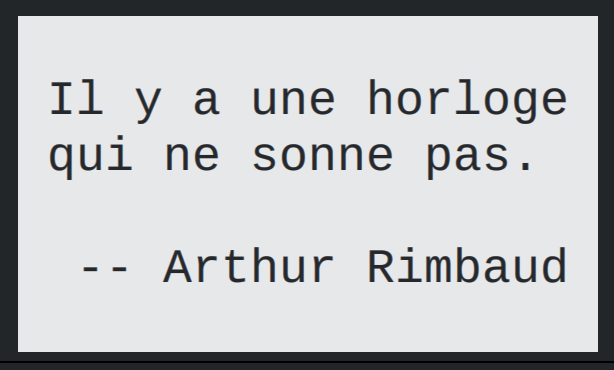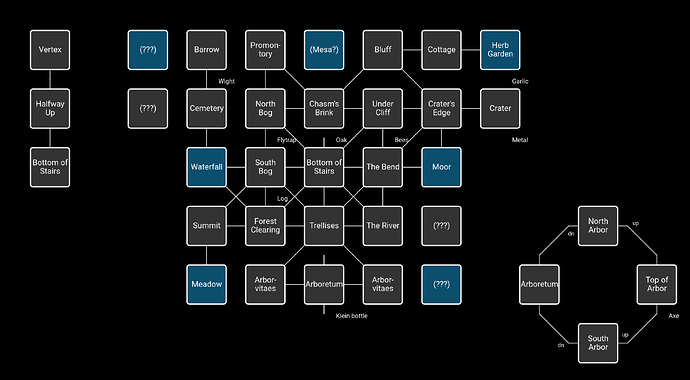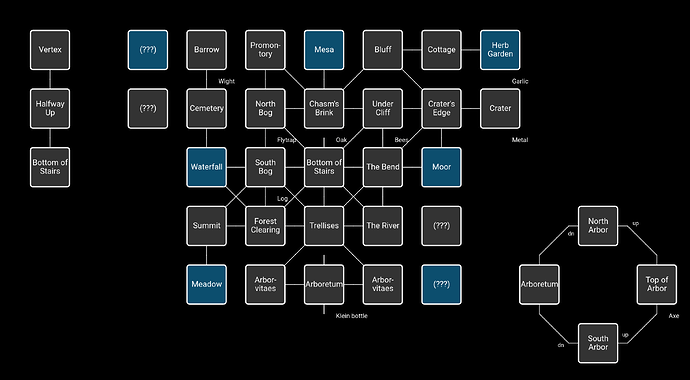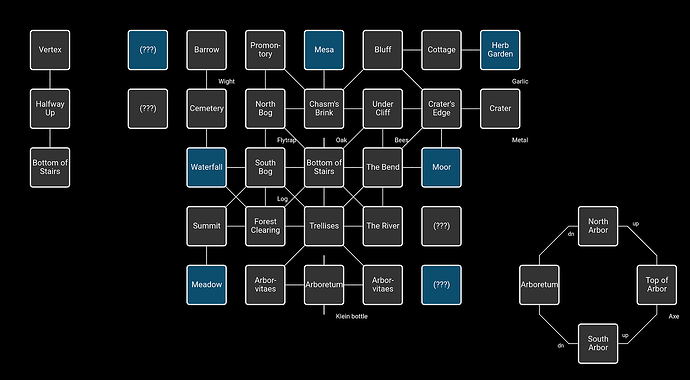Well, my final papers are in, now I just have a huge stack of assignments (or rather six huge stacks of assignments) to grade. Wish me luck.
In the meantime, let’s see what’s UP!
Arboretum
A spectacular pergola of arborvitaes arches over your head like a great green Ferris wheel. Its tangled surfaces are peculiarly twisted, making it difficult to tell where the inside ends and the outside begins.
Steep, leafy tunnels curve up into the pergola to the north and south. Other paths lead east and west, into the surrounding hedge.
An abstract sparkling sculpture stands between the tunnels. The words Felix Klein 1849-1925 are inscribed on the base.
We’re back at the Klein bottle pergola. Actually, wait, does it describe the shape?
>x pergola
The pergola resembles a doughnut, fifty feet across and woven entirely of arborvitaes. This “doughnut” is standing on end, and you’re gawking up at it from underneath. Steep, leafy tunnels curve up into the pergola to the north and south. The whole affair is oddly skewed; some parts look as if they’re turned inside out.
It does! So I think it is that other immersion of the Klein bottle I mentioned up above!
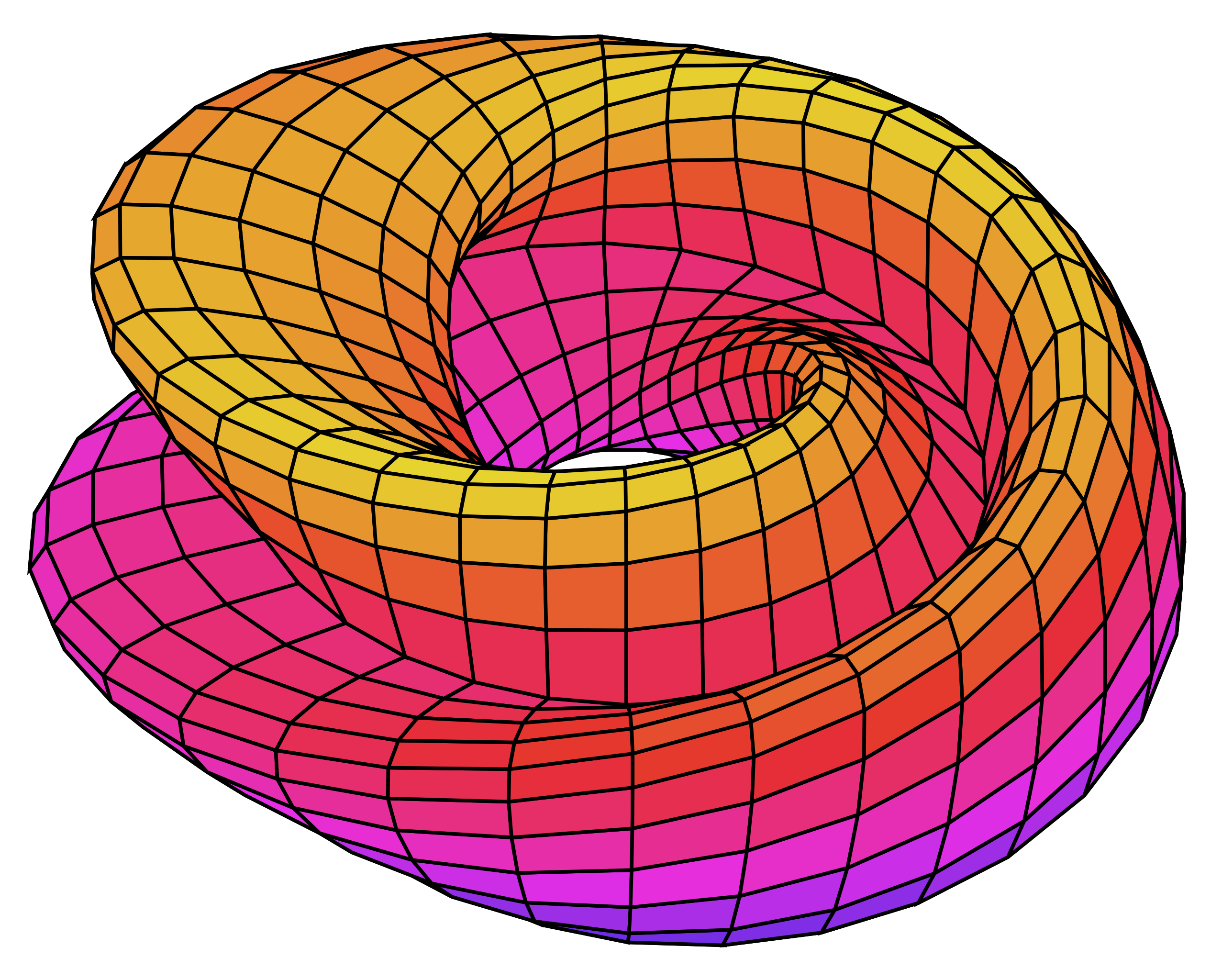
Just tipped on its side and woven out of trees.
>u
[Which way do you want to go up, north or south?]
Ah, the joys of Death on the Stormrider.
>n
You ascend the north side of the pergola.North Arbor
The “floor” of the pergola curves up and around in an inexplicable way that makes your eyes cross. It seems as if you’d be standing on your head if you went much higher. Little daylight makes its way through the thick walls of arborvitae.
Can we do a loop-de-loop?
>u
The floor twists alarmingly as you continue your ascent.Top of Arbor
The tangled vines and tendrils seem to writhe malignantly in the flickering light of the splinter. The air is pungent with the odor of arborvitaes.
Dark, leafy tunnels curve down to the north and south.
An arborvitae is cleaved by a silver axe.
Your sense of direction is very confused.
Wheeee!
Ooh, also an axe. That’s going to be good for chopping down trees.
>get axe
You yank the axe out of the arborvitae.[Your score just went up by 1 point. The total is now 17 out of 100.]
>x it
The silver blade is still sharp.
Gotta keep moving, if you stop at the top of a loop-de-loop you might fall.
>s
South ArborThe “floor” of the pergola curves up and around in an inexplicable way that makes your eyes cross. It seems as if you’d be standing on your head if you went much higher. Little daylight makes its way through the thick walls of arborvitae.
>d
The floor twists alarmingly as you descend.Arboretum
A spectacular pergola of arborvitaes arches over your head like a great green Ferris wheel. Its tangled surfaces are peculiarly twisted, making it difficult to tell where the inside ends and the outside begins.
Steep, leafy tunnels curve up into the pergola to the north and south. Other paths lead east and west, into the surrounding hedge.
An abstract sparkling sculpture stands between the tunnels. The words 5291-9481 nielK xileF are inscribed on the base.
That was fun!
Wait, what’s that on the sculpture?
The sparkling sculpture looks like a crystalline bottle, eight feet high, with a polished surface that twists in impossible curves. It’s hard to tell where the outside of the sculpture ends and the inside begins.
The words 5291-9481 nielK xileF are inscribed on the base.
Hm.
Well, probably nothing to worry about.
>e
ArborvitaesBarely eighteen inches separate the thick walls of arborvitae that tower on either side. They form an uncomfortably narrow corridor that bends sharply to the west and northwest.
>nw
TrellisesA fortresslike wall of arborvitaes stretches east and west through the forest. The only breach is an identical pair of arched trellises.
A mountain stream trickles between the trees. Paths wander from its banks in many directions.
>nw
The BendAn exhausted stream trickles into a river that bends to the south and west. The opposite shore is veiled behind a thick mist.
Paths meander off in many directions from the river’s edge.
A dark shadow moves slowly southwestward across the ground.
Wait, northwest to the Bend?
The river bending west?
>e
Bottom of StairsThe triangular structure before you must be thousands of feet high. It divides the sky like a razor, casting a stern, precise shadow over the surrounding landscape.
A narrow stairway climbs north, up the hypotenuse of the triangle. Footpaths converge on the stair from every direction.
Oh no. Abort abort abort!
By going once through the Klein bottle, we’ve inverted the world—what used to be the inside is now the outside, and east and west have been swapped!
In physics and certain types of mathematics, this is called a spinor: when rotating 360 degrees results in flipping everything backward, and you have to rotate another 360 degrees to get it back. Here’s a nice visualization with a Möbius strip:

When you’ve made one full rotation (from the blue arrow on the right to the red arrow), you’re flipped around; make another full rotation to un-flip things. Another famous demonstration is the “wine glass dance”. But it turns out they show up surprisingly often when you’re doing certain types of math, especially math involving rotations: you frequently end up with things that need to spin around twice to get back to their starting point.
Which means if we go north, up, south, down one more time, we should get un-flipped again!
An abstract sparkling sculpture stands between the tunnels. The words Felix Klein 1849-1925 are inscribed on the base.
Success!
The other place to explore upwards is the huge gnomon in the middle. So let’s see what we have there.
Bottom of Stairs
The triangular structure before you must be thousands of feet high. It divides the sky like a razor, casting a stern, precise shadow over the surrounding landscape.
A narrow stairway climbs north, up the hypotenuse of the triangle. Footpaths converge on the stair from every direction.
This isn’t going to be an easy trek. Thousands of feet straight up, times the square root of 2 (the angle of a gnomon depends on your latitude, but OSHA requirements say stairs can’t ascend at more than a 45 degree angle), means approximately 3000 feet of stairs at minimum. That’s over half a mile!
But, let’s give it a go.
With a fearful gulp, you ascend the narrow stairway.
Halfway Up
The breeze feels noticeably cooler here, about halfway to the vertex. The landscape below is gray in the shadow of the triangle.
Phew. Are we there yet?
No?
The air grows colder as you continue your ascent.
Vertex
The temperature on this tiny platform is well below freezing. But it isn’t just the cold that makes your teeth chatter when you look down that narrow stairway, thousands of feet high.
Far below, the shadow of the structure stretches across the landscape. From this great altitude it looks like a dark finger, accusing a point on the east horizon.
At the center of the platform stands a handsome antique sundial. You see a threaded hole on the dial’s face. The circumference is enclosed in a wide brass ring.
Wow! What a view!
Also, a sundial with a threaded hole—what a coincidence! (This is where you’d discover the game was unwinnable if you hadn’t found the Wabe back in Kensington Gardens.)
>x sundial
The perimeter of the sundial is inscribed with seven curious symbols and a compass rose, with the legend “TEMPUS EDAX RERUM” emblazoned across the bottom. A threaded hole is set into the center of the dial.
Oh dear, this is French. I can tell you that the Latin again says “time, devourer of all things” (or literally “time, gluttonous for things”), but my best guess at the French is something like…“this is a clock that doesn’t chime”? I guess that would make sense for a sundial.
And finally…
>put gnomon in hole
You twist and push the gnomon into the hole on the sundial, but it doesn’t seem to fit very well. A quick glance shows the reason why. The thread on the bolt doesn’t match the thread in the dial’s hole.
We’ve come all this way, and it doesn’t even fit?!
It looks like these threads turn in opposite directions. Is this gnomon really useless after all?
Next time: making use of the pergola, and chopping down a tree!
03b.txt (10.0 KB)
